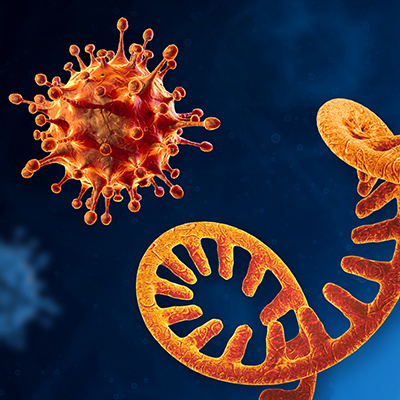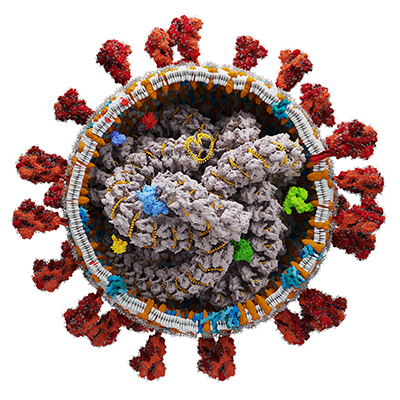May 26, 2021 -- A new study has uncovered the interactions that SARS-CoV-2 RNA establishes with the host cell proteins, many of which are fundamental for infection. The results, published in Molecular Cell on May 24, pave the way for the development of new therapeutic strategies for COVID-19 with broad-range antiviral potential.
SARS-CoV-2 carries its genetic material in RNA, which must be multiplied, translated, and packaged into new viral particles during infection. However, the RNA viral genome cannot encode all the proteins required to support replication, so the virus overcomes this limitation by hijacking cellular RNA-binding proteins (RBPs).
Cellular RBPs are important regulators of the virus life cycle because they can sense unusual molecular signatures and trigger the cellular antiviral state to suppress viral gene expression via the inhibition of protein synthesis and production of interferons.
A team led by researchers at the University of Oxford, University of Glasgow, and University of Heidelberg used multiple proteome-wide approaches to discover the role of RBPs in the life cycle of the SARS-CoV-2 virus.
The team started by using a new method called comparative RNA interactome capture (cRIC) to determine active RBPs in SARS-CoV-2 infected cells. The foundation of the technique relies on RNA interactome capture (RIC) which uses in vivo ultraviolet (UV) crosslinking, oligo(dT) capture, and proteomics to selectively identify RNA-binding proteomes. The analysis revealed that SARS-CoV-2 infection initially causes subtle remodeling of cellular RBPs but becomes much more pervasive in the later stages of infection.
Further interrogation of the whole cell proteome of SARS-CoV-2-infected cells provided evidence that over 5,000 RNAs display significant fold changes compared to control RNAs and that viral RNAs become abundant substrates for cellular RBPs during infection.
Moreover, the authors noted that post-translational control may also contribute to the differential RNA binding activity observed in dozens of RBPs in SARS-CoV-2 infected cells.
To identify the RBPs that interact directly with SARS-CoV-2 RNA, the researchers developed a new approach called viral RNA interactome capture (vRIC), similar to RIC and cRIC. The method uses UV crosslinking; however, it is specific to the photoactivatable nucleotide analogue 4-thiouridine (4SU)-containing viral RNA. Following elution, proteins copurified with the viral RNA are analyzed by proteomics.
This analysis identified a total of 139 RBPs enriched from SARS-CoV-2 infected cells compared to control. The interactome was enriched for RBPs associated RNA metabolism (RNA splicing, transport, stability, and silencing and translation), antiviral response, cytoplasmic granule assembly, and virus biology (viral process, dsRNA binding, and viral RNA translation).
The vRIC data showed that SARS-CoV-2 RNA engages with a broad range of cellular RBPs, including classical and unconventional RNA binders. It also revealed six viral RBPs that interact with RNA. These include the polyprotein open reading frame (ORF) 1a/b, nucleocapsid, membrane, spike protein, and ORF9b. Interestingly, the study found that the membrane, spike protein, and ORF 9b are novel RBPs.
An unexpected observation of this study is that viruses from different origins, such as SARS-CoV-2 and the Sindbis virus, hijack a similar repertoire of cellular proteins. Sindbis is a positive-stranded virus from the alphavirus genus. Both SARS-CoV-2 and Sindbis produce subgenomic RNAs and replicate in the cytoplasm of host cells. The cRIC results indicated that 40% of the changes in RBP activity observed in SARS-CoV-2 were also present in the Sindbis.
Furthermore, the team found that 60% of the RBPs within the SARS-CoV-2 RNA interactome were also present in the Sindbis RNA interactome. This discovery is very important, as cellular proteins with important and wide-spread roles in virus infection are potential targets for broad-spectrum antiviral treatments.
"These exciting results are only the beginning," said Alfredo Castello, PhD, from the University of Oxford, in a statement. "With hundreds of compounds that target these critical cellular proteins, it will be possible to identify novel antivirals. Our efforts, together with those of the scientific community, should focus now on testing these drugs in infected cells and animal models to uncover which ones are the best antivirals."
The researchers tested five drugs in SARS-CoV-2-infected cells and found that two of these compounds targeting heat shock protein 90 (HSP90) and insulin-like growth factor 2 MRNA binding protein 1 (IGF2BP1) caused a strong inhibition of SARS-CoV-2 protein production. Two additional drugs targeting ELAV-like RNA binding protein 1 (ELAVL1) and Musashi RNA binding protein 2 (MSI2) caused moderate effects, and one pyruvate kinase M1/2 (PKM)-targeting compound had only slight effects.
"In this stage of the pandemic in which vaccines have proved their value," Castello added, "it becomes fundamental to develop new therapeutic approach to counteract emergent vaccine-resistant variants or novel pathogenic viruses with pandemic potential."
Do you have a unique perspective on your research related to infectious diseases or virology? Contact the editor today to learn more.
Copyright © 2021 scienceboard.net








